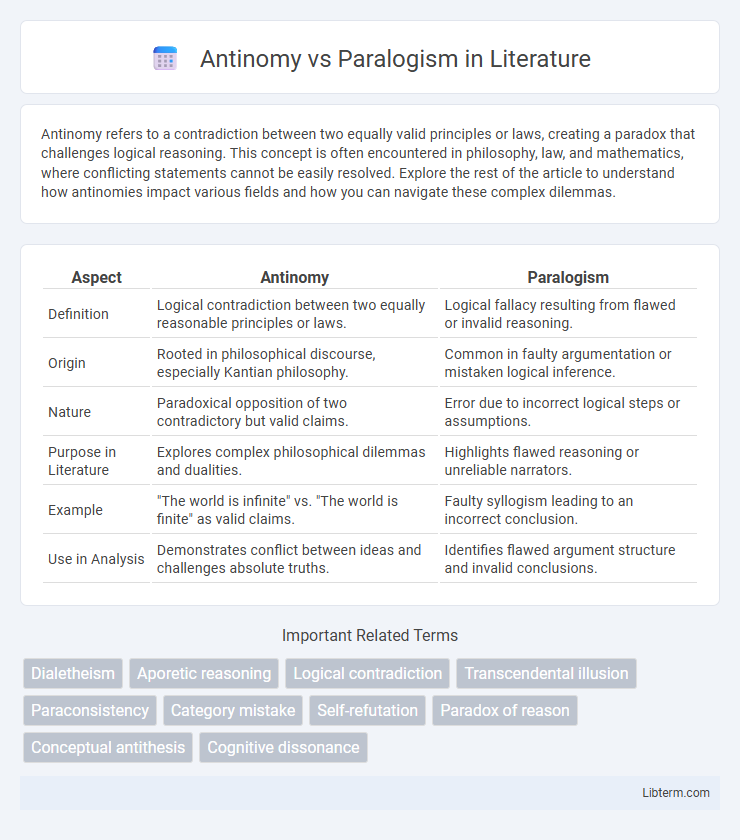Antinomy refers to a contradiction between two equally valid principles or laws, creating a paradox that challenges logical reasoning. This concept is often encountered in philosophy, law, and mathematics, where conflicting statements cannot be easily resolved. Explore the rest of the article to understand how antinomies impact various fields and how you can navigate these complex dilemmas.
Table of Comparison
| Aspect | Antinomy | Paralogism |
|---|---|---|
| Definition | Logical contradiction between two equally reasonable principles or laws. | Logical fallacy resulting from flawed or invalid reasoning. |
| Origin | Rooted in philosophical discourse, especially Kantian philosophy. | Common in faulty argumentation or mistaken logical inference. |
| Nature | Paradoxical opposition of two contradictory but valid claims. | Error due to incorrect logical steps or assumptions. |
| Purpose in Literature | Explores complex philosophical dilemmas and dualities. | Highlights flawed reasoning or unreliable narrators. |
| Example | "The world is infinite" vs. "The world is finite" as valid claims. | Faulty syllogism leading to an incorrect conclusion. |
| Use in Analysis | Demonstrates conflict between ideas and challenges absolute truths. | Identifies flawed argument structure and invalid conclusions. |
Introduction to Antinomy and Paralogism
Antinomy refers to a contradiction between two equally rational principles or laws, often encountered in philosophy and logic when two valid propositions conflict irreconcilably. Paralogism, on the other hand, denotes a logical fallacy or erroneous reasoning that appears superficially plausible but is fundamentally flawed. Understanding the distinction between antinomy and paralogism is crucial in philosophical analysis and critical thinking, as antinomies challenge the limits of rationality while paralogisms expose faulty argumentation.
Defining Antinomy: Philosophical Context
Antinomy in philosophy denotes a genuine contradiction arising from equally valid principles or reasoning, highlighting limitations in human knowledge or logic. Immanuel Kant famously explored antinomies to demonstrate conflicts between reason and experience, such as the paradoxes of infinite space or causality. Unlike paralogism, which involves logical fallacies or errors in reasoning, antinomies reflect inherent tensions within rational thought itself.
Understanding Paralogism: Logical Fallacies
Paralogism refers to a logical fallacy arising from erroneous reasoning or flawed inferential steps that appear valid but are fundamentally incorrect. Unlike antinomies, which involve genuine contradictions between equally valid principles or laws, paralogisms result from mistakes such as ambiguous premises, invalid deductions, or deceptive argument structures. Recognizing paralogisms is crucial for critical thinking and refining logical analysis to avoid fallacious conclusions in philosophical or mathematical discourse.
Key Differences Between Antinomy and Paralogism
Antinomy refers to a genuine contradiction between two equally rational principles or laws, often found in philosophical or logical contexts, whereas paralogism is a formal fallacy involving flawed reasoning or a logical error that appears valid. Antinomies highlight the limits of reason by presenting unresolved conflicts, while paralogisms expose errors caused by incorrect inference. Understanding these distinctions is crucial for distinguishing between inherent conceptual paradoxes and simple mistakes in logical argumentation.
Historical Origins and Development
Antinomies and paralogisms emerged as critical concepts in 18th-century philosophy, particularly in Immanuel Kant's "Critique of Pure Reason." Antinomies refer to contradictory yet rationally plausible propositions about the universe's nature, revealing limits of pure reason in metaphysics. Paralogisms describe fallacious reasoning patterns, especially in rationalist arguments about the self, highlighting errors in naive metaphysical speculation.
Examples of Antinomy in Philosophy
Kant's Critique of Pure Reason presents classic examples of antinomies, such as the conflict between the universe having a beginning in time versus being infinite and eternal. Another prominent antinomy involves the debate on whether causality is deterministic or if freedom and spontaneity exist. These examples illustrate fundamental contradictions inherent in human reason when it attempts to grasp the totality of metaphysical concepts.
Examples of Paralogism in Reasoning
Paralogism in reasoning refers to flawed or illogical arguments that appear valid but contain hidden errors, commonly seen in subjective biases or false generalizations. Examples of paralogism include hasty generalizations, such as concluding all dogs are aggressive after a single encounter, or affirming the consequent in conditional statements like assuming that if it rains, the ground is wet, then deducing it rained simply because the ground is wet. These fallacies contrast with antinomies, which involve genuine contradictions arising from reason itself, not errors in reasoning.
Impact on Epistemology and Logic
Antinomy and paralogism profoundly influence epistemology and logic by challenging the limits of knowledge and reasoning. Antinomies reveal contradictions within valid reasoning, prompting critical analysis of fundamental principles in epistemology, while paralogisms expose errors in reasoning processes, highlighting the importance of logical rigor. The examination of these phenomena advances the understanding of cognitive boundaries and the structures necessary for sound knowledge acquisition.
Resolving Antinomies and Avoiding Paralogisms
Resolving antinomies requires identifying and reconciling contradictory but valid principles within a consistent logical framework, often through critical examination of underlying assumptions and redefinition of terms. Avoiding paralogisms involves rigorous adherence to proper reasoning rules, ensuring conclusions follow valid logical inferences without fallacious errors or ambiguous premises. Mastery in distinguishing valid paradoxes from illogical arguments enhances clarity and precision in philosophical and analytical discourse.
Conclusion: The Importance in Critical Thinking
Antinomy and paralogism highlight crucial distinctions in critical thinking by revealing different types of reasoning errors; antinomy exposes inherent contradictions within a system or argument, while paralogism identifies flawed logic caused by invalid inference. Understanding these concepts sharpens analytical skills, preventing acceptance of contradictory conclusions or fallacious reasoning in philosophical and everyday debates. Emphasizing their importance strengthens intellectual rigor and promotes clearer, more coherent argumentation.
Antinomy Infographic

 libterm.com
libterm.com